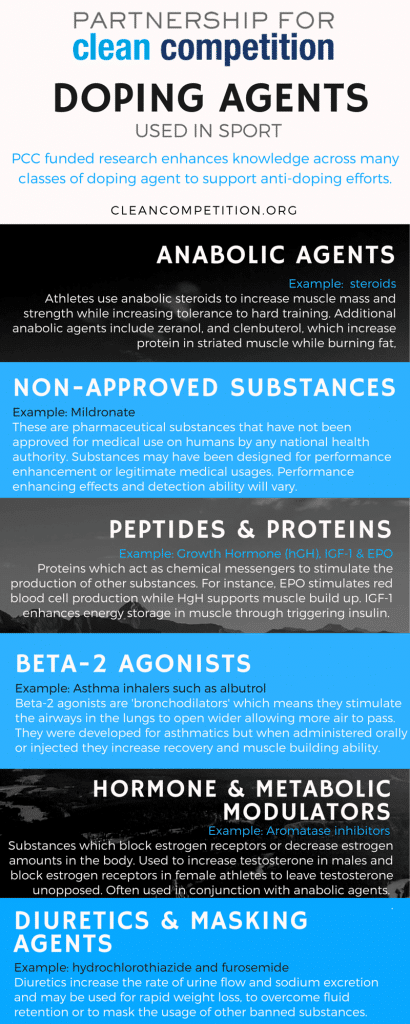A common misconception of doping in sport is that the problem is confined to substances like steroids and growth hormone (HGH) which promote the growth of skeletal muscle. However, the scope of doping, and thus the research that must accompany it, goes far beyond anabolic agents.
While anabolic steroids and HGH remain a considerable threat to the integrity of sport, they are far from the only performance enhancing drugs (PEDs) used by contemporary athletes. In fact, anabolic agents make up only one of five categories representing the World Anti-Doping Agency’s (WADA) Prohibited List [1]. Other categories include hormonal and metabolic modulators, diuretics and masking agents, peptides and proteins, and beta-2 agonists (which provide anabolic effects when administered orally). Furthermore, there is a special category addressing designer drugs, or those lacking governmental approval which may provide performance enhancing effects. The number of adverse analytical findings (AAFs) for each category reported to WADA in 2014 are as follows:
| Category | Number of AAFs | Percentage |
| Anabolic Agents | 1479 | 48% |
| Diuretics and Other Masking Agents | 389 | 13% |
| Hormone and Metabolic Modulators | 145 | 5% |
| Beta‐2 Agonists | 122 | 4% |
| Peptide Hormones, Growth Factors and Related Substances | 91 | 3% |
| Other | 853 | 27% |
While anabolic agents do represent the highest percentage of AAFs across sports, it is important to understand that increased muscle mass is not the only advantage pursued by those seeking a competitive edge. Endurance athletes may seek substances which aid muscle recovery, enhance oxygen delivery through the blood, or increase energy. Athletes with weight classes may strive to lower body fat percentage. Precision athletes might pursue substances that increase focus or remove jitters.
PEDs may be substances originally developed for legitimate medical problems (such as EPO), or designer drugs crafted covertly to provide an edge. Certain substances containing prohibited agents are available over the counter, while others are illegal, difficult to obtain, and/or available only in particular regions. Doping may occur over long periods of time to supplement training or be taken on the day of competition. The ‘how and what’ of doping is incredibly diverse and so too must be the research.
The following infographic provides an overview of how PEDs in each WADA category may be used in doping.
According to Larry Bowers, Chief USADA [3] Scientist and PCC Scientific Advisory Board chair, [4] there are more than 200 known substances and/or analytes currently making up the Prohibited List, all of which athletes must be tested for.
By extension, this means researchers must develop efficient and effective testing protocols, determine relevant threshold data (where relevant), and ensure scientific understanding of the biological interaction of more than 200 substances – not including designer drugs currently in development. This vast and dynamic field of anti-doping science thus requires the acumen of scientists from all over the world. The PCC’s mission is to support these scientists through efficient and innovative funding programs.
In order to ensure that research which seeks answers to imminent anti-doping questions receive precedence, the PCC has developed research priorities [5] through important discourse with anti-doping leaders, sporting league representatives, and the PCC Scientific Advisory Board. Priorities include classes of substance which deserve attention (such as peptides and proteins), collection methods, laboratory excellence, and ways to enhance testing methodology. For instance, in 2015, 50% of funded projects focused on EPO and blood doping research – a subject which required an influx of scientific attention and discovery – while research on anabolic agents represented 22% of projects. In future grant cycles, attention may be given to projects which advance technology related to the detection of designer PEDs and methods which reduce the costs of testing.
These diverse priorities highlight the need for an influx of investigators able to perform high-quality scientific research which advances anti-doping knowledge of a variety of substances – including those which have yet to be detected or proven as performance enhancing. Studies which advance knowledge of commonly abused PEDs must occur alongside studies which detect and classify their innovative, often more sophisticated counterparts.
So while steroids and growth hormone may be the ‘poster substances’ for doping in sport, they are far from the only substances on the radar of anti-doping scientists.
If you’d like to contribute to the research essential for fighting doping in sport, please visit cleancomp.wpengine.com to learn more about our funding programs.
